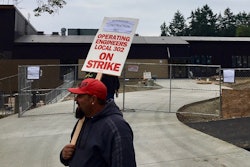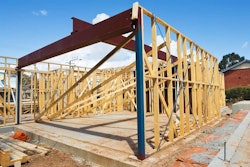 The scene after an excavation collapse at a cesspool installation site in Shoreham, New York, killed Kurt Peiscop-Grau on November 18, 2017. Source: OSHA investigation file
The scene after an excavation collapse at a cesspool installation site in Shoreham, New York, killed Kurt Peiscop-Grau on November 18, 2017. Source: OSHA investigation fileIn a split second, the ground opened beneath Edward Sinnott, sucking him down 20 feet.
As Sinnott slid rapidly down and was immediately buried, a contractor working beside him grabbed a clamshell bucket and was hoisted to safety.
Sinnott wasn’t so lucky. It took rescuers six hours to recover his body May 24, 2017, on a cesspool installation job at a home in Huntington, New York. Before the collapse, he had been using hand signals to direct his employer who was operating a truck-mounted crane.
Six months later in Shoreham, New York, about 35 miles from Sinnott’s demise, a similar death occurred.
This time, the ground collapsed beneath Kurt Peiscop-Grau, cascading him into an excavation that was 17 to 22 feet deep where he was buried alive. He, too, had been directing his employer in a crane operation to install a cesspool.
And in both cases, Don Antorino, owner of Don Antorino Sewer & Drain, was operating the crane.
The U.S. Occupational Safety and Health Administration’s Long Island office found his company at fault in both deaths. But the company was fined only $14,830 for Sinnott’s death and $12,934 for the death of Peiscop-Grau.
The death cases might have ended there, but Sinnott’s son, Michael Uliano-Sinnott of Huntington, has filed a $50 million lawsuit against Antorino and the other companies working on the cesspool installation site.
Uliano-Sinnott’s lawyer, Susan Karten of New York, says the current penalties for excavation safety violations do nothing to prevent such collapses that kill workers.
“It was outrageous that there were absolutely no safeguards at the site,” Karten says.
“… It’s like a bunch of cowboys set up and they don’t have to adhere to anything, any rules, regulations. And afterwards, OSHA comes in and slaps them on the wrist, and business is back to usual.
“Particularly in this case, when six months later, the same exact thing happened.”
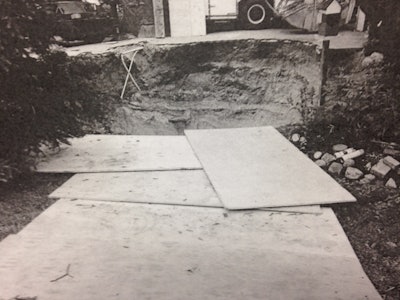 Edward Sinnott fell into this excavation and died May 24, 2017, in Huntington, New York. Source: OSHA investigation file
Edward Sinnott fell into this excavation and died May 24, 2017, in Huntington, New York. Source: OSHA investigation fileDeath No. 1
Work started at 7:30 a.m. May 24, 2017, to install cesspool rings in a yard on Beech Place in Huntington.
Around 12:50 p.m., Antorino, 66, a subcontractor on the site, was operating a 35-ton, 1979 Link-Belt truck-mounted crane.
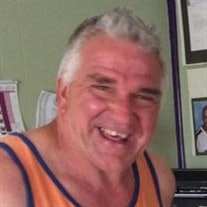 Edward Sinnott
Edward SinnottSinnott, 60, had worked for Antorino for 2-1/2 years and was 5 to 6 feet deep in the excavation directing Antorino’s bucket placement. The clamshell bucket was digging inside the 10-foot-diameter ring while Sinnott was standing beside the ring, according to the OSHA report. General contractor Bart Pember was beside Sinnott in the excavation, also giving hand signals.
Suddenly, the ground collapsed beneath Sinnott, and Pember grabbed the bucket and was lifted out. Sinnott was sucked into a 20-foot-deep hole, according to OSHA.
Suffolk County police arrived and reported the incident to OSHA at 2 p.m. OSHA arrived at 3:46 p.m.
At 7 p.m., Sinnott’s body was pulled from the hole, and he was pronounced dead. He left behind a wife, a son and stepson, according to his obituary.
Antorino told the OSHA investigator he had not directed Sinnott to enter the excavation and did not know he was in it. He said he could see Pember, who was beside Sinnott.
Antorino said he was taking hand signals from a worker who was standing on the steps of the house and from a worker standing above ground outside the excavation.
“I never asked Eddie to go inside an excavation,” Antorino told OSHA. “The last time I saw Eddie he was by my utility truck.”
The worker standing at the house steps, identified in the OSHA report as a “subcontractor,” said he believed Sinnott entered the excavation to direct Antorino. “I would have thought Don was able to see Ed inside the hole. Ed was Don’s ground guy. Don was glancing at me but was also looking at the hole. … I was standing at the step of the house. I was giving the signals mimicking Ed.”
During an interview with OSHA about a month after the incident, Antorino spoke “about how bad he feels over his friend’s death and how dangerous it is working blindly with a clamshell bucket when you have to rely on someone else giving directions about how deep you are.”
According to the OSHA report, Antorino said he might have removed too much soil from beneath one of the cesspool rings, causing instability and a void that pulled Sinnott in.
“I just followed directions to dig blindly,” he told OSHA.
On November 20, 2017, OSHA issued two serious citations to Don Antorino Sewer & Drain. One for $3,803 for employees not wearing hardhats while working beneath a crane bucket. The other was for $12,675 for employees not having adequate cave-in protection while working 5 to 6 feet below grade.
In all, the penalties amounted to $16,478.
Antorino contested the penalties, and the fines were reduced to $14,830.
OSHA also issued similar citations and penalties to PNZ Incorporated dba Antorino & Sons, which was the contractor on the site. The company lists Bart Pember as its CEO, according to the New York State Department of State.
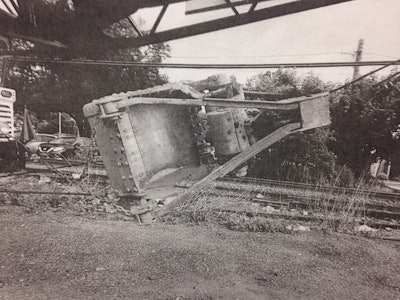 Don Antorino was using this clamshell bucket May 24, 2017, during a cesspool installation in Huntington. Bart Pember, CEO of PNZ Incorporated dba Antorino & Sons, was able to grab onto the bucket and was hoisted to safety. Source: OSHA investigation file
Don Antorino was using this clamshell bucket May 24, 2017, during a cesspool installation in Huntington. Bart Pember, CEO of PNZ Incorporated dba Antorino & Sons, was able to grab onto the bucket and was hoisted to safety. Source: OSHA investigation file
Death No. 2
On November 18, 2017 – two days before OSHA issued its citations from the May 24 collapse – Antorino was operating a truck-mounted 1970 Link-Belt crane for a cesspool installation in Shoreham. Work had started around 8:30 a.m.
The OSHA report said work had been occurring on the site for four or five days before the collapse. Antorino had begun excavating on November 16, but it started to get dark, so he backfilled the hole and returned November 18.
On November 18, Kurt Peiscop-Grau, 61, was standing near the excavation directing Antorino with hand signals.
Antorino was using the bucket, which was attached to the crane by a chain, to try to compact the sides of the excavation, the OSHA inspector was told.
“He realized that the excavation was not stable because at times when he would hit the side of the excavation it would collapse,” the report said. “He attempted to pack the sides so that it would stop collapsing; however, he did not remove his employee from the danger zone even though he was aware that the ground had been predisturbed, was alternating clean sand and clay, and that the soil was giving way throughout the course of the work.”
Around 11:20 a.m., the excavation collapsed and sucked down Peiscop-Grau. He was pinned between a concrete cesspool ring and the dirt that had covered him.
Workers jumped into the hole to try to save Peiscop-Grau.
Firefighters arrived to find employees digging by hand to try to rescue Peiscop-Grau. It took two hours to recover his body. He left behind a son.
OSHA did not receive a report of the incident from Shoreham police until 4:20 p.m., after Peiscop-Grau’s body had been recovered. On November 19, an OSHA official spoke with police and collected preliminary information, and on November 20, an OSHA inspector arrived on the scene, according to the OSHA report.
Because of the changes to the excavation from the recovery effort, rain and backfilling, the OSHA inspector could not determine the depth of the excavation before collapse, but estimated it to be anywhere from 17 to 23 feet deep and at least 20 feet wide.
“No one was able to provide a definite answer regarding width and depth of hole,” the report said.
There was also a discrepancy as to how close Peiscop-Grau was to the excavation. Workers said he was 10 feet away, but the inspector determined that “at best he was 4 feet from the hole.”
He also noted the previous work on the property, including when Antorino had backfilled the hole on November 16.
“The ground had been disturbed several times, compromising its stability, information that Antorino would have known and understood to mean as such,” says the OSHA report.
Antorino did not want to talk to the inspector until another person, whose name was redacted from the report, arrived on the scene. However, when that person arrived, Antorino said he had to fix his crane, so he could continue to work on the jobsite.
OSHA reported it faced delays in getting Antorino, who had been subpoenaed, in for an interview. He invoked his Fifth Amendment rights and did not speak to OSHA.
The OSHA investigator noted the May 24 death of Sinnott in the report:
“The employer had a previous fatality approximately six months prior to this incident involving similar scope of work.”
But the report also said, “However, there is no directly related history.”
The report also noted a failure by Antorino to write a safety and health program, which Antorino had told OSHA on June 1 he would do after Sinnott’s death. OSHA tried to subpoena that information after the second death. But on January 8, 2018, OSHA was informed by Antorino’s lawyer that there was “no safety and health program in place.”
The report indicated Antorino had been working in the business since 1972 and was the competent person on site.
On May 16, 2018, Don Antorino Sewer & Drain was issued a citation for a serious violation for an employee working in an unstable adjacent area of a 17- to 22-foot excavation. The proposed penalty was $12,934, which Antorino settled on June 7, 2018, for a 10 percent reduction to $11,640.60.
Why fines so low?
When asked why Don Antorino Sewer & Drain was not issued a repeat violation for the November 18, 2017, incident, an OSHA spokesman said the violations are similar, but “the conditions were different.”
A repeat violation can bring a $126,749 penalty.
“The necessary elements to issue a ‘Repeat’ citation in the second instance could not be established,” according to Jim Lally, deputy regional director of public affairs for the U.S. Department of Labor. “In the first instance the employee was performing work below ground ‘in’ the excavation. In the second instance the employee was ‘outside’ the excavation above ground. The employer permitted him to work in an unstable adjacent area.”
In an email, Lally cited the exact wording of the citations.
The citation for the May 24 violation reads:
“Each employee in an excavation was not protected from cave-ins by an adequate protective system …”
The citation for the November 18 incident reads:
“Where the competent person found evidence of a situation that could result in a possible cave-in, indications of failure of protective systems, hazardous atmospheres, or other hazardous conditions, exposed employees were not removed from the hazardous area …”
Both citations were deemed “serious,” which means the employer knew or should have known of a hazard that could result in serious injury or death. In both cases, Antorino was initially charged the maximum penalty for a serious violation.
The agency’s decision on Antorino “seems procedurally justified,” since the company was cited under different parts of the standards, said Jordan Barab, former OSHA deputy director who writes the “Confined Space” newsletter on workplace safety and labor issues.
However, Barab believes that all trench collapse death cases “should result in a willful violation to be followed by criminal prosecution.”
A willful violation is the highest OSHA violation, meaning that the employer intentionally disregarded the law or was indifferent to employees’ safety or both. Willful violations carry a maximum $126,749 penalty. They can also lead OSHA to request the U.S. Department of Justice seek criminal prosecution; however, the agency says such cases are difficult to prove. Such referrals are rarely made.
An employer convicted in a criminal case can face a fine of $250,000 or six months in jail or both. A corporation could be fined $500,000.
Karten believes OSHA’s fine for the November 18 incident that killed Peiscop-Grau was too low.
“The second fine should have been a lot larger in view of the first incident. It wasn’t. It was the same thing,” she says. “We appreciate the fact that they go in and do an investigation, but it doesn’t seem to stop this kind of behavior.”
The lawsuit
On January 26, 2018, Michael Uliano-Sinnott sued Don Antorino Sewer & Drain for the death of his father.
The suit also lists as defendants PNZ dba Antorino & Sons, Don Antorino Crane Service and other companies allegedly on the site May 24, 2017, as well as the homeowner and the town of Huntington.
According to the wrongful death suit, which seeks $50 million, workers were not provided harnesses or life lines and were not required to wear hardhats. There was no shoring or other method to stabilize the excavation. The suit says Antorino instructed Sinnott to enter the excavation, which had no ladder or other safe means to enter and exit. Excavated materials were stored on the edge of the excavation, and Sinnott and other employees were not properly supervised.
Sinnott died of “asphyxia due to compression of torso and occlusion of airways,” the suit said.
In their responses, all of the defendants denied the allegations and said that Sinnott knew the risks of the profession and voluntarily took those risks. They labeled him a “recalcitrant worker,” alleging he refused to use safety devices.
Don Antorino Sewer & Drain’s response also said the company is protected against litigation by workers’ compensation law.
The defendants have filed cross-claims against one another.
Attempts to reach Antorino and his lawyer for comment were unsuccessful.
John Guglielmo, who represents Bart Pember and PNZ dba Antorino & Sons, declined to comment and said Pember would not comment, due to the pending litigation.
What’s next?
Karten, who filed the lawsuit, said that despite the deaths, nothing has changed. The companies returned to work as usual.
She sent a letter to the Suffolk County District Attorney’s Office alerting it to the two deaths for possible criminal investigation but received no response.
“I didn’t even get a letter of acknowledgement … which to me indicates that these things aren’t taken seriously,” she said. “Until these owners or contractors face some criminal liability, nothing changes.”
Attempts to reach the D.A.’s office for comment for this article were unsuccessful.
Local prosecutors in some areas of the country, including in New York, have filed criminal charges in recent trench-collapse death cases.
As to the fines for the two deaths, Don Antorino Sewer & Drain has been paying by monthly installments, according to OSHA records.
Aside from the lawsuit, the company faces no other apparent repercussion.
It’s possible, too, that under workers’ compensation law, the company could be protected from litigation. However, there is an exception to such protection under New York law when “there is grave injury or death,” says Craig Snyder, a lawyer in Karten’s firm.
He explained that there is also some confusion as to who Sinnott’s employer actually was and who was directing workers on the site. And with so many companies with “Antorino” in the name, such confusion will have to be sorted out through depositions.
Karten said she plans to bring up both deaths when arguing the case and also mentioned there was another case involving an Antorino Sewer & Drain of Islandia, N.Y., that was cited by OSHA in 2009 after a worker was injured in an excavation collapse.
Karten believes the company is related to the other Antorino businesses.
“There are a lot of questions about who the Antorinos are and which Antorino works where and where our client worked,” Karten says. “So we have to get to the bottom of it, because I see it as a clear-cut liability case.”
In the 2009 incident, a worker was trapped in a 16-foot excavation while installing cesspool rings in East Hills, N.Y. The worker survived with no major injuries after being buried up to his waist for more than four hours. Antorino Sewer & Drain was fined $11,700.
OSHA said the excavation lacked cave-in protection, did not have a safe means of exit and had not been inspected by a competent person. The worker was also not wearing a hardhat and had entered the excavation while riding in a bucket.
In a 2010 news release about the incident from the Long Island OSHA office, which also investigated the two death cases, Area Director Anthony Ciuffo issued the following statement:
“An unprotected excavation can become a grave in seconds and nearly did so here. This incident is a stark example of how dangerous it can be inside an excavation that lacks proper sloping or shoring, especially in the low cohesive and sandy soil we have here on Long Island.”
For more on trench and excavation collapses, see Equipment World‘s special report Death by Trench.






